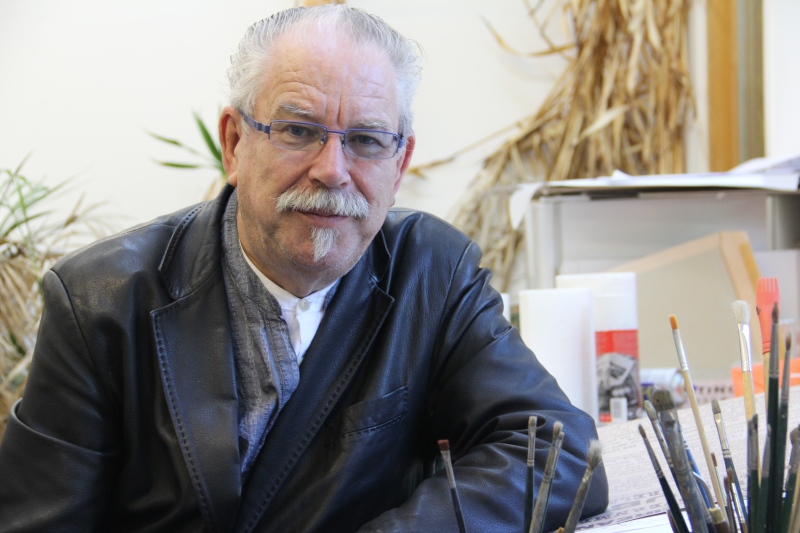The public lecture entitled “Robert Ballagh Talks Pop at Trinity” took place yesterday evening as part of the series of events taking place in conjunction with the Trinity College Gallery collection’s latest exhibition “The Swing of the Sixties” at the DLR Lexicon Library. Ballagh delivered a deeply personal account of his colourful life and his rise to fame as an artist, with a series of charming stories and witty anecdotes. The talk also outlined the pivotal role that Trinity Collection’s plays in both the acquisition and conservation of important works and the potential influence on young artists.
Ballagh was a pioneer of pop art in Ireland and has had a profound impact on the face of Irish art, yet modestly dubbed himself an “accidental artist” in his opening lines last night. With early dreams of life as a musician he saw moderate success, playing shows in Ireland, the UK and America. However he decided to retire from the world of rock and roll and sold his guitar to a young aspiring musician, Phil Lynott. Ballagh joked that even if he did not reach stardom, at least his guitar did.
It was a night in Toners, a pub which Ballagh frequented, where he would receive his crucial “accidental” introduction to the art world, when he met the artist Michael Farrell who offered him a job that payed “£5 a week and all the drink you can take”. Despite having practically no experience in the art world, Ballagh eagerly accepted and it was his work with Farrell that made him want to become an artist.
He began working in the 1960s, a period of enormous change not only in art, but also in wider Irish society. In 1966 the Trinity College Gallery was established and in 1968 the gallery showed an exhibition of pop art “Light in Movement” – largely from the USA – including works by renowned artists such as Roy Lichtenstein, and the sharp, bright images had a huge impact on Ballagh’s approach to art. Coming from a background of no formal artistic training and relatively little experience, he felt that he would be able to “do” pop art. His modesty again shone through when he recalled how a critic had once called him “Ireland’s greatest pop artist” which he denounced saying that he was “Ireland’s only pop artist”.
Ballagh wanted to use his new medium of pop art to express his worries about current events such as the Vietnam war. One work which hung next to Ballagh in the theatre as he spoke proved to be the perfect example of Ballagh’s use of art as a political tool. “Series 4 no. 3”, which is part of the Trinity Collection, shows two students who were shot while peacefully protesting the Vietnam war. The purchase of this work was instigated by Prof Anne Crookshank, who was keen for the collection to be curated by students. Ballagh recalled how she ushered no less than 40 students to his small inner city home and sent them in three at a time to view his studio, later huddling together outside his gate where they voted to purchase the work.
He began to see a great deal of success, largely due to his series of paintings of people looking at famous artworks which also features in Trinity’s collection. However political themes persisted in his work and in the 1970’s he produced three works in response to the Troubles in Northern Ireland: “The Rape of the Sabines after David”, “The Third of May after Goya” and “Liberty on the Barricades after Delacroix”. The inspiration of these works came from some of the most renowned works of 19th and 20th century artists, but Ballagh reinvented them in the style of pop art, modernising their themes. At this point, Trinity Curator, Catherine Giltrap, interjected stating that the three works exist in the College Collection in print form, and are by far the most popular pieces in the art hire scheme.
Later in his career he became celebrated for his work in portraiture. One of his earliest commissions for a portrait was of Gordon Lambert, a piece which he was nervous to paint as he was concerned about his self-perceived lack of skill. His solution was to silkscreen a photo of Lambert’s face onto the canvas and paint over it, which was seen as a highly innovative technique of modern art but was simply a means of avoiding his creative weaknesses. Other portraits of Ballagh include those of Louis le Brocquy, Fidel Castro, James D Watson and Francis Crick.
Ballagh’s work features in the current exhibition in Dun Laoghaire which shows a variety of artworks from both Irish and international artists, and his is some of the most influential pop art produced in Ireland. When asked what his favourite pieces in the collection were, he responded with a chuckle by saying “never ask an artist what they like” but did reveal that he felt a personal connection with the works of Michael Farrell from his time spent working with him.
This is the first in a series of special events taking place as part of “The Swing of the Sixties” exhibition, which is now showing in its final location after touring throughout Ireland. This evening a talk titled “The Swinging Sixties: Pop Culture” will take place in Dun Laoghaire examining the influence of pop culture on society in the 1960s.







